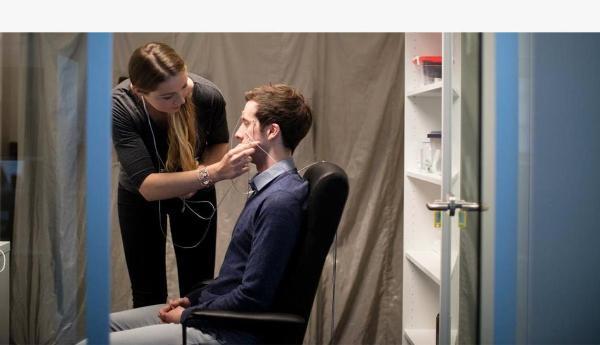Italian hearing-care firm Amplifon invests and digitalises to serve a growing population with hearing problems
Marco Giachetti wasn’t yet 40 when he began to lose his hearing. At first, he tried to ignore it, but with age, his condition worsened. “When I was with family or friends, more and more often I would isolate myself, because I found it challenging to participate in conversations,” says Giachetti, who is now 67. “Noisy environments were hard to handle, and so was going to the cinema or theatre.”
So Giachetti decided to seek help. “It was the need for sociability that prompted me to find a solution.”
He turned to Amplifon, a global hearing-care retailer based in Italy, where an audiologist, or hearing specialist, fitted him with a device.
Giachetti is not alone. About 1.5 billion people have some degree of hearing loss, and 430 million people — over 5% of the world population — suffer from disabling hearing loss that needs rehabilitation. This number is expected to pass 700 million by 2050, according to the World Health Organization. Untreated hearing loss costs nearly $1 trillion a year globally in terms of health sector and societal costs, productivity loss and educational support. Investment in devices that improve the lives of sufferers is important, as populations grow older.
- Read about creating music for the hearing impaired
Investing in health
Amplifon began as a small store in Milan, opened in 1950 by Algernon Charles Holland, a former British special forces officer. It now has a global network of 9 500 shops and hearing clinics and some 20 000 collaborators worldwide. Susan Carol Holland, the daughter of the founder, is the majority shareholder of the company, and the remaining shares are listed on the Milan Stock Exchange.
In July, the European Investment Bank signed a €300 million loan with Amplifon (the first part of €350 million in financing approved by the Bank) to help the company continue innovating, digitalising and improving its services.
“Half of the investment is dedicated to health — it’s an investment in the silver economy,” says Radek Ossowski-Barbetti, the European Investment Bank senior loan officer who originated the loan.
The prevalence of hearing loss increases with age, and over 25% of people over 60 today are affected by it. In addition, untreated hearing loss presents an increased risk of dementia. But the risk is 17% lower for people with hearing loss who use hearing aids, according to a recent study in The Lancet.
“The other half of the investment is in research, development and innovation,” Ossowski-Barbetti adds.
Another aspect of Amplifon’s digitalisation and innovation plan appealed to the European Investment Bank. The plan will benefit Amplifon’s customers in Europe and around the world, but 18.5% of the investment will be in so-called cohesion regions, in line with Europe’s policy of investing in its economically weaker regions to raise living standards.
Amplifon also has a clear diversity and inclusion policy in support of gender equality: 56% of its board of directors, 44% of managers, and 72% of the total workforce are women. Nearly half of the staff occupy STEM positions (roles in science, technology, engineering and mathematics), and women make up 67% of those roles.
The high cost of hearing loss
In addition to increasing the risk of dementia, untreated hearing loss can affect other aspects of life, including:
- communication and speech
- education (in some developing countries, children with hearing loss and deafness do not attend school)
- employment (unemployment is much higher for adults with hearing loss)
- stigma and social isolation
Amplifon estimates that through the free hearing tests it provided in 2022, the company allowed the healthcare systems of the 25 countries in which it operates to save €289 million.
- Read about creating music for the hearing impaired
Innovative technology
The company does not produce hearing aid devices, but develops innovative hearing aid software and services, such as:
- medical-grade certified iPad-based audiometers (devices to evaluate hearing levels)
- software to increase the smart connectivity of hearing aids
- digital medical protocols
- software development kits for remote adjustments and interaction with hearing aid devices
- other highly innovative digital solutions that rely on data mining and data analytics
Amplifon aims to use data to create “a more personalised audiological experience,” says Enrico Vita, Amplifon’s chief executive officer. “With the data we collect we can get to know our customers better and gain insights into how they use their hearing aids. And with this information, we can improve our service, for example through personalised follow-up treatments and remote care.”
Marco Giachetti marvels at the evolution of Amplifon’s hearing aids since he first became a customer 25 years ago.
“The first devices, the old-generation ones, were more difficult to use than those available today,” Giachetti, a resident of Florence, says. “You always need an adaptation period, but the technology and the expertise of Amplifon’s staff helped a lot. And now, sometimes I even forget to take out my device.”

Tackling tinnitus
Another auditory affliction that affects 10-15% of the global adult population is tinnitus, a phantom sound that does not have an external source. It is usually described as a ringing sound, but some people experience it as a high-pitched metallic whistle or roaring or buzzing. It is audible only to the person suffering from it.
A company in Ireland, Neuromod Devices has developed a device that pairs tongue and sound stimulation to help attenuate tinnitus. The company calls this dual mode stimulation “bimodal neuromodulation.”
The device, Lenire®, has CE certification, meaning it meets EU safety and health requirements, and also received De Novo certification from the US Food and Drug Administration this year, so it can now be distributed also in the United States.
Since its inception, Neuromod Devices has financed itself with equity and debt from several investment partners.In March 2023, the European Investment Bank signed a €15 million venture debt agreement with the company to help it further develop the device’s innovative functionalities and clinical development and begin commercialising in additional European countries.
